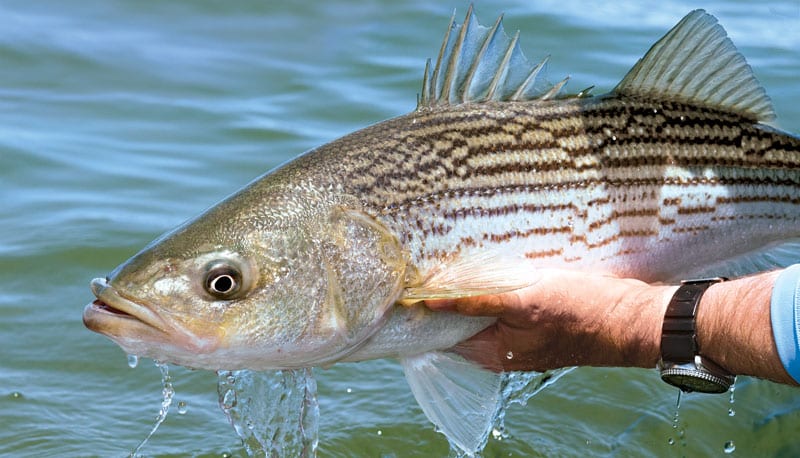
With most fly-anglers, mention the term sight-fishing, and pictures of palm-tree-lined beaches, shallow flats, transparent waters, and species such as bonefish, permit and tarpon come to mind. While these images are stereotypes for good reason, I enjoyed an outstanding sight-fishery in an unlikely spot last May. Until then, I had always associated the area with individuals who dressed in brand-name pastel golf shirts tucked into seersucker clam-digger pants and used the word summer as a verb.
This is where the city dwellers of New York’s Manhattan escape to for beachside retreats — the Hamptons of Long Island.
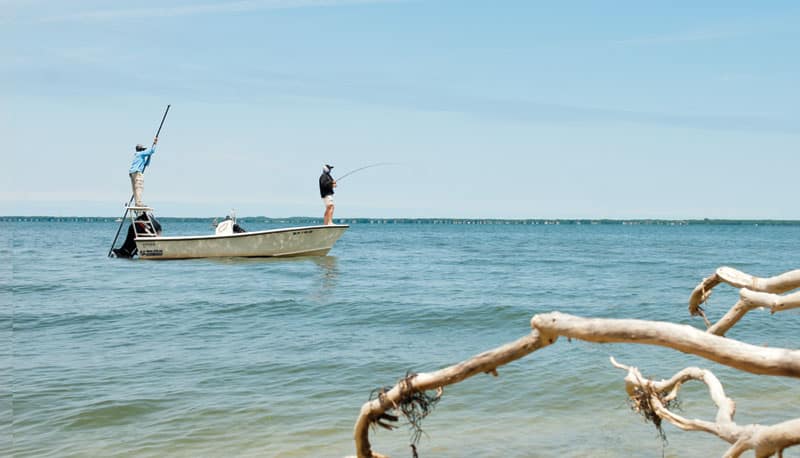
My preconceptions were completely off, as it was nothing like I imagined. The hospitality of the locals and the well-manicured vineyards and wineries scattered along both sides of quiet roads were pleasant and welcome surprises that made me forget that the Big Apple and its fast-paced lifestyle were only miles away. After setting the hook on my first sight-fished striped bass of the trip, I had to laugh and ask myself, “Why wouldn’t someone want to summer in the Hamptons?”
For the past few years, Fly Fishing in Salt Waters publisher Gary Jennings has come into the office extra jovial after returning from his trip to the Hamptons each May. The stories he’s told about the size and number of quarry and the overall quality of fishing would cause any angler to raise an eyebrow. So when the opportunity came to test the spot with one of the fishiest guides I know, I simply couldn’t resist. Capt. Craig Cantelmo has lived and fished the Shinnecock and Peconic Bay area for the past 30 years and knows the surrounding waters well.
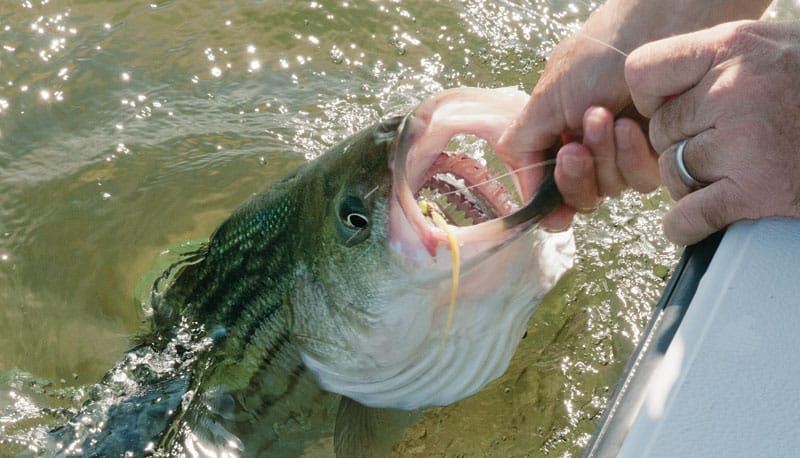
When Jennings and I pulled into the boatyard, Cantelmo was already at the helm of his 19-foot Steiger Craft, a wide-beamed vessel that he personally customized to be poled along the shallows. “Poling the Steiger keeps me lean and mean,” he later told us. While the boat might require a little extra elbow grease to maneuver, it proved a perfect weapon in Cantelmo’s hands.
After loading all our gear, we idled out of the marina into open water, and Cantelmo informed us that we had timed our trip perfectly. Weather conditions looked good, water temps were up, and winds were light. Finally, I’d get to see what all the fuss was about.
When we reached the first spot, Cantelmo took to the poling platform, and Jennings grabbed his 9-weight and stepped up onto the bow. As they kept their eyes on the water, I found it difficult to keep from looking at the giant mansions that lined the beach and wondering which debutante or actress might make her way out onto a dock. My daydreaming quickly came to a halt when Cantelmo enthusiastically whispered, “Gary, 50 feet, I got a fish at 11 o’clock.” Jennings’ relaxed posture instantly changed, and his eyes became fixed right where Cantelmo was looking. Once he spotted the fish, he quickly dropped the fly, made a single false cast and put the small Clouser in front of the bass. Though Cantelmo has caught his fair share of stripers, he coached Jennings’ retrieve with as much excitement as if it were the first time he’d ever seen a bass. Jennings’ stripping cadence brought the fish almost to the bow before it finally decided to eat. He set the hook, and the fish countered by taking off for deeper water. After Jennings brought the fish boat-side, he looked at me and said, “I told you. You’re up.”
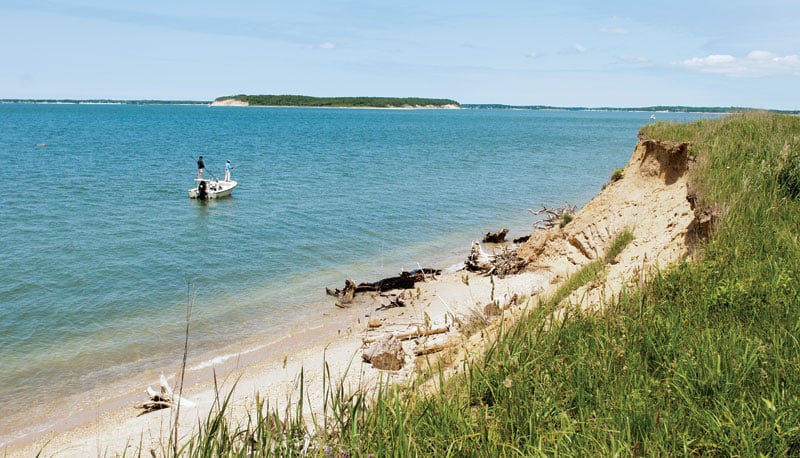
By the time Jennings rinsed the fish slime from his hands, I was already in position. Cantelmo kept a watchful eye from his perch while Jennings stood right behind me to help spot fish. All was quiet, and we experienced a lull. To make conversation, I asked Cantelmo where the fish came from.
He explained that while some of the fish are holdovers, most come into Peconic Bay and head through Shinnicock Canal and around the corner of Orient Point to make their way to their summer grounds off Rhode Island. Because these fish come from the ocean, they should be pretty fresh, which means they should eat well — in theory.
The lull continued, and I looked down into the clear water and noticed pod after pod of baitfish. Just then, Cantelmo put Jennings and me both at ease by saying that, with all the sand eels around, something good was bound to happen any minute. And sure enough, after Cantelmo made another couple of shoves with the pole, his voice perked up once again as he told me he saw a fish cruising just off the beach. My untrained eyes squinted, but by the time I saw the fish, it had seen me too, and it took off. I found that despite the clarity of the water, the silvery flanks of the striped bass, along with their dark lateral lines, camouflaged them perfectly. It took a while, but making out their shape and the slight bluish tinge of their fins became slightly easier eventually.
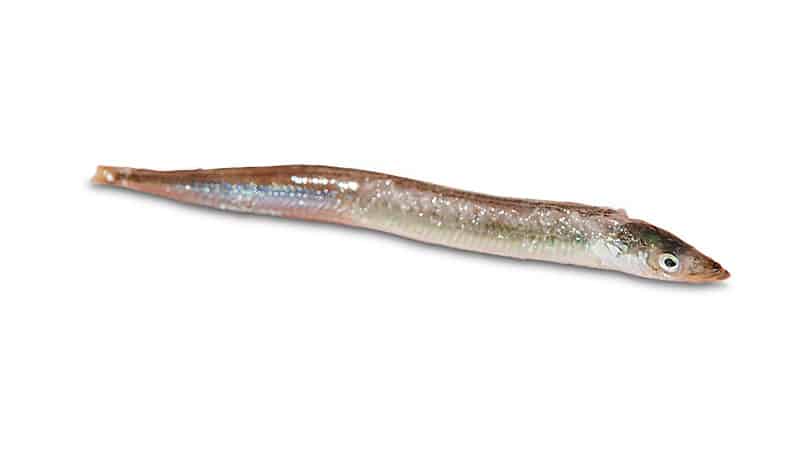
The day wore on, and Jennings and I both managed several decent-size fish, and Cantelmo even plucked a few from atop his platform. As the outing came to a close, Cantelmo explained that by his standards, the action was slow. I, on the other hand, thought the day was a great success; if this was below average, I couldn’t wait for tomorrow. Over dinner, Cantelmo pointed out that in addition to the fun of it, there exists a strategic reason for targeting the bay flats of the Hamptons — especially early in the season. The shallow bays heat up much faster than the ocean, and stripers simply don’t like the water any cooler than 42 degrees or so. Cantelmo said that as the fish slowly move across the Atlantic and feel the warm water spilling out of the bays, many of them follow the warmth into the shallows. Bay fishing can be especially productive during a late-afternoon outgoing tide. Also, the majority of these shallow-water bays have dark bottoms, which heat up dramatically faster than flats with lighter sandy bottoms. At times, Cantelmo’s checked his temperature gauge to find that the water over a dark bottom in 2½ to three feet of water is as much as 4 or 5 degrees warmer than the surrounding water.
Over the years, Cantelmo has discovered spots by paying attention to water temperature. “Anytime I’m going to be actively throwing flies where there are cruising fish, I’m going to search for water that’s around 50 degrees,” he said. “Obviously, as the summer progresses, the water will get warmer, and there comes a point when the flats shut down.
As a matter of fact, as a rule of thumb, when the bays’ nighttime water temperature reaches 70 or above, you can expect the action on the flats to slow. What happens is that, as the water heats up, its propensity to hold oxygen drastically drops, so a tremendous amount of oxygen is lost from the water, and the fish then move out. Flats that hold fish have a good flush of water, and more than anything else, that’s to keep the sand eels around. If the sand eels leave, so do the bass. Whenever I’m fishing a new area around here, I look for flats near open water to ensure a good push of water during the incoming tide, and when all else fails, I also look for bluffs. Typically the bluffs will have a flat somewhere out in front. If I find one that has dark bottom and open water nearby, I know stripers will eventually take up residence on it.”
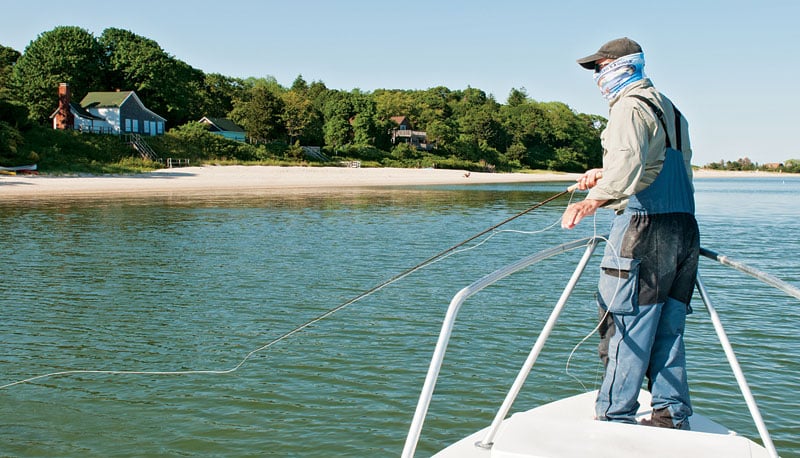
The next morning, we were greeted by conditions much like the day before’s, but the scenery was slightly different. Cantelmo poled us along a public beach that was jampacked with kids playing with beach balls and adults trying to rid themselves of the pale skin caused by city life. To nonlocal vacationers, we must have been quite a sight. Two masked men standing in the bow of a boat being pushed along by another man with a big stick. All of us saw the humor in this, but Cantelmo had us so close to the sand, we couldn’t even laugh without the beachgoers hearing us. Jennings was on the bow, and once again, an animated Cantelmo yelled, “Gary, cast right at your feet!” Jennings made an easy roll cast, and the fish ate. Before we knew it, we had an audience, which was now perfectly aware of why we were there.
Cantelmo agreed that this fishery is indeed unique. One minute you can be fishing an area reminiscent of a Bahamian bonefish flat, and the next you can fool yourself into thinking you are chasing tarpon along a beach in Florida.
“A lot of guys up this way fish ocean-bay flats where the fish come in directly from the ocean onto the sand flats. The bays I normally fish up here remain clear for most of the season,” explained Cantelmo. “We also tend to get a bigger body of fish here because the water heats up so much faster and therefore attracts more fish. Each year, it’s a little different, but for the most part, the telltale sign that the fishing is about to turn on is when the ospreys begin to show up, which happens right around the same time the schools of big bunker appear in the bays. That’s really what drives a lot of the larger fish into the shallows early; they are after a meal with some sustenance behind it.” Cantelmo said that once the water temperature reaches 60 degrees or so, the bunker will move out, and the stripers that remain will end up targeting the young-of-the-year sand eels that spawn right around that time.
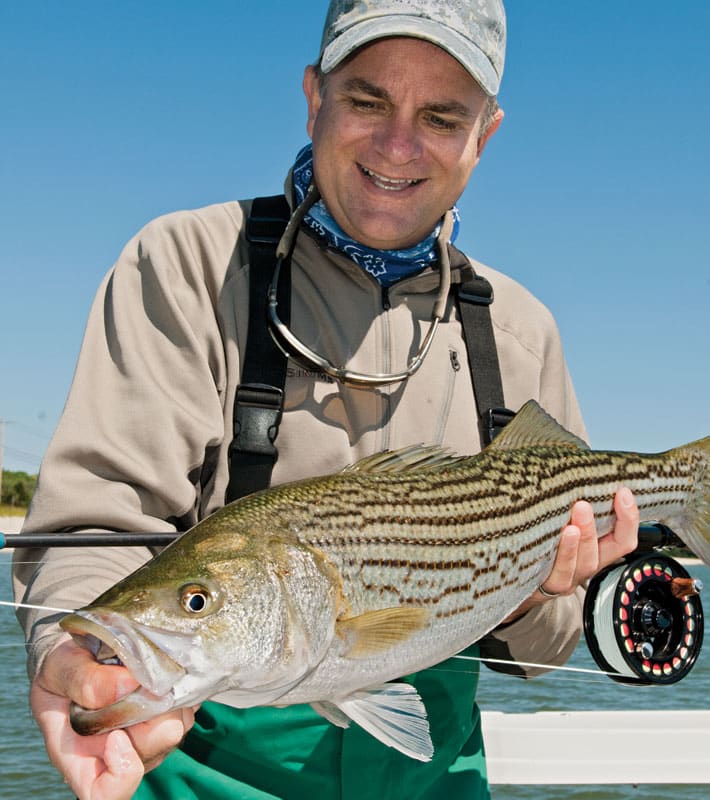
The sand eel spawn Cantelmo spoke of was in full effect during our stay. On the third and final day of fishing, we could look over the side of the boat and see them in droves at any given moment. The eels had been around the previous two days, but not like this, and the abundance of food really turned on the bass. By this time, Jennings and I had both hit a groove and seemingly had to wait only a minute or two between shots. I’ve never really been the type of angler who counts how many fish were caught over the course of a day, but I will say that by the end of this one, the fingerprint on my thumb was completely gone from my lipping so many bass to remove hooks.
Even though striped bass and the Northeastern wine-country mansions dotted along the beaches of the Hamptons don’t necessarily scream sight-fishery, one’s there — and believe me, it’s one of the best you’ll encounter. I’m not sure I’ll ever adopt the dress code of the Hamptons, but you can mark my words: I’ll be “summering” there as often as I can.
Trip Planner
Basically, the outfits you’d use for any other inshore sight-fishing destination will work just fine. The one thing that you should pay attention to is your fly box. If you plan to fish really early in the season, large baitfish patterns that mimic bunker will yield good results, but as the season moves on, you will definitely want to have a healthy selection of sand-eel-type flies. For the most part, we used sparsely dressed, heavily weighted Clouser Minnow-style patterns. If you plan on going anytime after the second week of June, make sure to have a good selection of crab designs. Cantelmo says that around this time, the calico crab spawn takes place, and when it does, the stripers will not feed on anything that doesn’t look like a crustacean.
Rods: An 8-weight will cover most situations, but be mindful that bass in the 20- to 25-pound range do appear, and in this case, a 9- or 10-weight might be a better fit.
Reels: Spool large-arbor reels that have smooth drags with plenty of backing.
The fish here can be pretty spunky.
Lines: Floating weight-forward lines should be all you need.
Leaders: Taper the leaders from a 40-pound butt section down to a 12- to 16-pound tippet.
Flies: Enrico Puglisi baitfish patterns in olive-and-white for early season. High-tied, sparsely dressed and heavily weighted Clouser Minnows in yellow-and-white to match the midseason sand eels. At the end of the season, quarter-size crab patterns are key.
Hamptons Connection
Paying attention to water temperatures, flats around bluffs, and moving water will contribute to a successful day. However, the biggest tip for a do-it-yourself angler is to spend a lot of time looking. While the area has fantastic fishing, as with anywhere else, it pays to do your time. A lot of the water looks fishy, but unless you really know the area, finding a productive spot can be tricky. If you want to get in on the action faster, I highly recommend chartering one of the area’s experienced guides.









